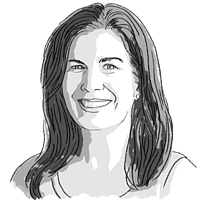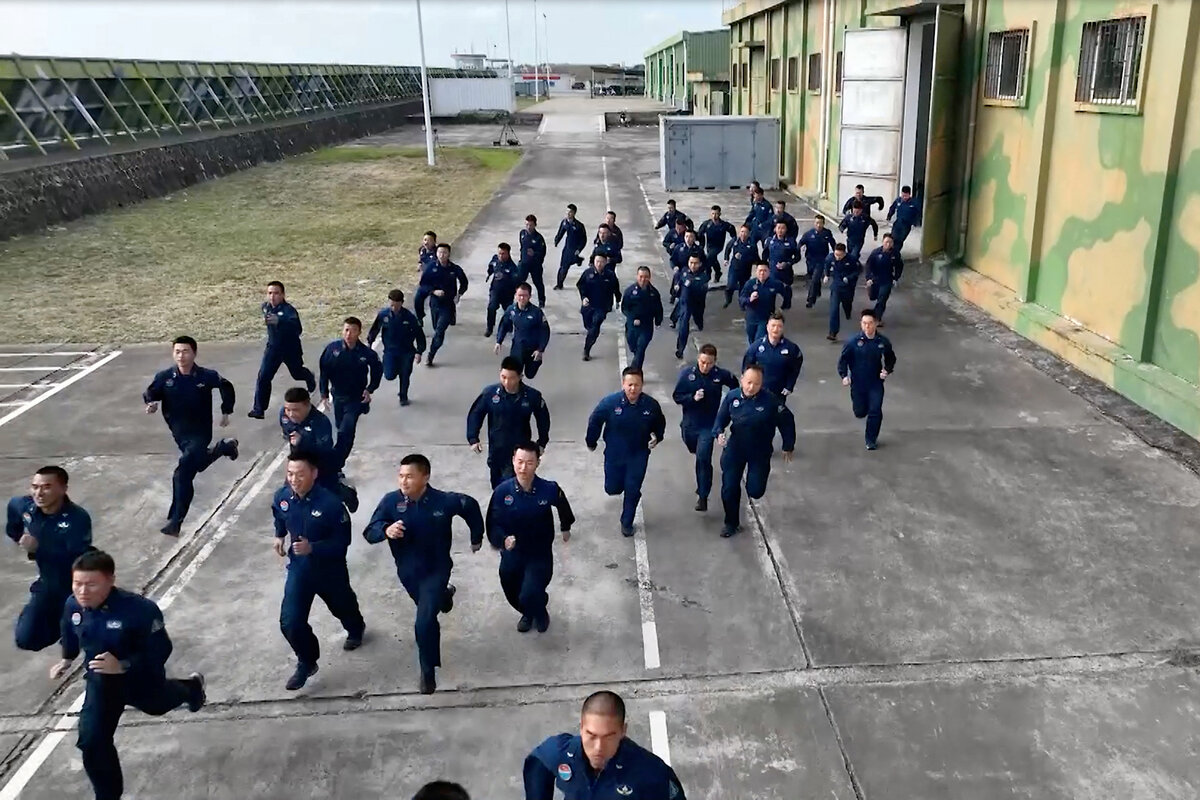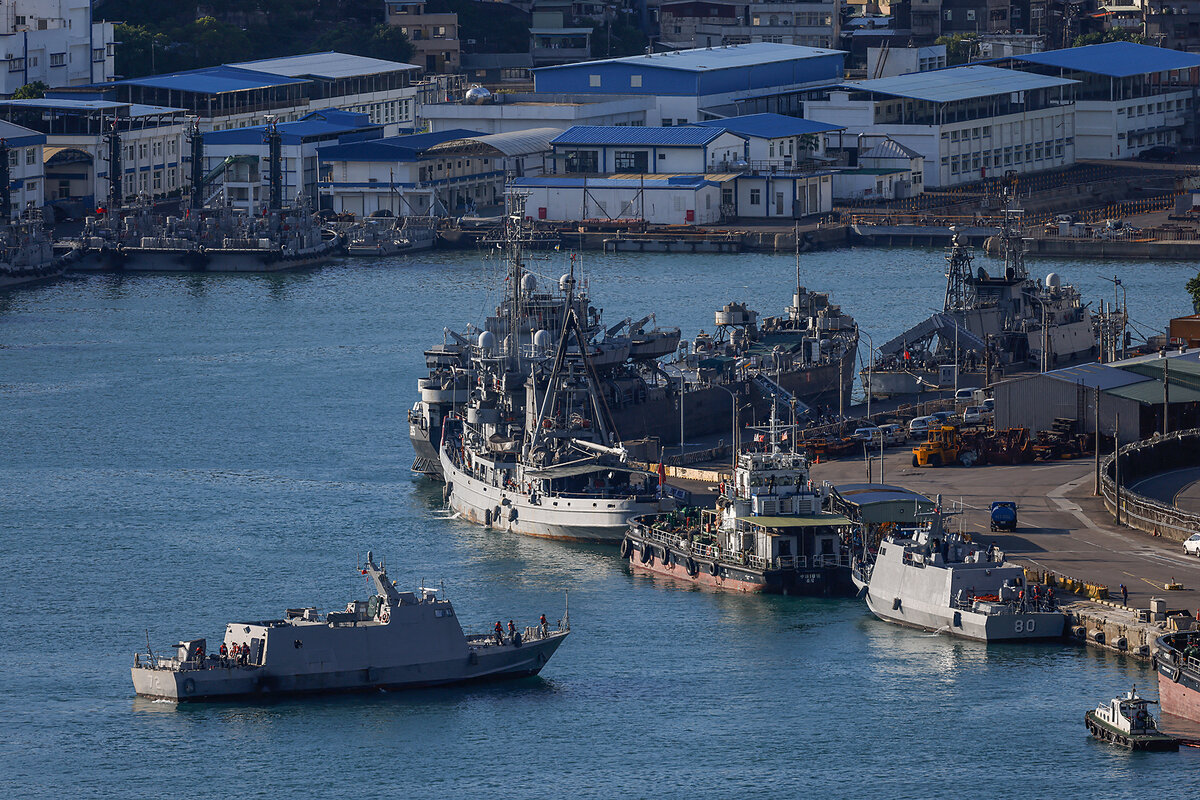China’s latest drills highlight key strategy to annex Taiwan: Blockade
Loading...
| Beijing
China’s military is intensifying preparations to seize Taiwan, should Beijing order the use of force to subjugate the democratic island of 23 million people.
The People’s Liberation Army (PLA) is dispatching growing numbers of air force jets, naval ships, and troops in mock takeover drills, while gradually encroaching deeper into the waters and skies surrounding Taiwan.
A massive PLA joint exercise last week practiced blockading the island – Beijing’s latest escalation in its use of the military “stick” to try to coerce Taiwan into unification. China’s Communist-led government has never ruled Taiwan, but has claimed the island for decades and vowed to annex it – by force, if necessary.
Why We Wrote This
China’s military is practicing putting a choke hold on Taiwan – a strategy that defense experts increasingly believe could be an effective alternative to a full-scale invasion. What would such a blockade mean for Taiwan, and its allies?
“China is using force to show ... its intentions, its credibility, and its resolve – and all that adds up to a pretty dangerous state of affairs,” says Drew Thompson, senior fellow at the S. Rajaratnam School of International Studies at Nanyang Technological University in Singapore.
China creeps closer
The latest drills involved a record 125 aircraft and drew closer to the island than previous ones. China’s first aircraft carrier, the Liaoning, took part, as did a significant number of vessels from China’s coast guard, the largest in the world. Dubbed “Joint Sword,” the drills simulated cutting off key Taiwan ports and assaulting sea and ground targets, according to China’s Eastern PLA Theater Command.
Beijing made it clear that the overarching goal of the military action was political – calling it “a stern warning to the separatist acts of ‘Taiwan Independence’ forces,” in the words of PLA spokesperson Senior Capt. Li Xi. The drills came just days after Taiwan’s new president, Lai Ching-te, gave a national day address in which he vowed to “resist annexation or encroachment upon our sovereignty.”
Indeed, a day after the Oct. 14 military exercises, Chinese leader Xi Jinping visited an island county in southeastern Fujian province just across the Taiwan Strait from Taiwan, and called for promoting “national identity among Taiwan compatriots.” Mr. Xi’s message to Taiwanese was unmistakable – economic, trade, and cultural benefits await those who cooperate with the unification goal, while those who resist will meet with military retaliation.
Mr. Xi “is personally calling the shots on Taiwan,” says David Sacks, a fellow for Asia studies at the Council on Foreign Relations. “[He’s] trying to split Taiwan and ... show there is another path.”
China’s growing use of force around Taiwan also has concrete military benefits for China, experts say, with the exercises providing important training in joint operations for PLA forces.
Moreover, the frequent, ever-closer incursions of PLA jets and ships are effectively shrinking Taiwan’s warning time, Taiwan defense officials say. They serve to wear down Taiwan’s much smaller military by forcing it to respond continuously – day or night.
They also help normalize the Chinese military presence, making it more difficult for Taiwan’s defenders to gauge when an action marks the first stage of an actual attack, or just another patrol – potentially giving China a greater element of surprise.
“It’s increasingly difficult to recognize the difference between a routine exercise or patrol, and the opening salvo of a conflict,” says Mr. Sacks, which could “help China with a bolt from the blue or a decapitation strike on Taiwan.”
What a blockade would mean for Taiwan
The PLA maneuvers also provide useful information to Taiwan and its main unofficial ally, the United States, which is bound by American law to provide the island with the means to defend itself.
For example, the drills highlight China’s preparations for blockading Taiwan, either as a stand-alone coercive measure or as a precursor to a full-scale invasion, experts say.
Taiwan is vulnerable to a blockade. International trade accounts for about two-thirds of Taiwan’s gross domestic product. And the island relies on imports for nearly 100% of its energy and 70% of its food, according to a recent analysis by the Center for Strategic and International Studies in Washington.
China’s coast guard played a major role in the latest exercise, surrounding Taiwan with its vessels for the first time. “This was a concrete action to manage and control the Taiwan island in accordance with the one-China principle,” coast guard spokesperson Liu Dejun said in an official statement.
Employing the coast guard to quarantine Taiwan would allow Beijing to depict its actions as internal law enforcement – a move that could complicate international intervention on Taiwan’s behalf, experts say. By controlling access to Taiwan by commercial ships and aircraft – even temporarily – it could advance its sovereignty claims, while undermining the credibility of Taiwan’s government.
In contrast, a full-fledged PLA military blockade of Taiwan would be considered an act of war.
Beijing could impose a full blockade to try to compel the Taiwan government to capitulate to China’s unification demands – without firing a shot. But this would also afford time for the U.S. military and potentially other allies to come to Taiwan’s defense.
Indeed, Taipei’s surrender is far from a given. “Democracy is the core of Taiwanese identity,” says Mr. Sacks, and many people on Taiwan “would be willing to fight and die to protect that democracy.”
Taiwan has roughly doubled its defense budget over the past decade, and increased military conscription to one year. It is also stockpiling food, energy, and other supplies. Since his inauguration as president in May, Mr. Lai has launched an initiative to strengthen Taiwan’s resilience in national defense, disaster prevention, and democracy.
Mr. Lai responded to last week’s PLA exercise by pledging to beef up Taiwan’s coast guard with 11 new ships over the next seven years, according to CNN.
“Taiwan’s investment in societal resilience decreases the probability that China can mount a successful blockade,” says Mr. Thompson, a former director for China, Taiwan, and Mongolia at the U.S. Defense Department.
The U.S. and its allies are working together with Taiwan to counter China’s growing military assertiveness with stronger deterrence. On Sunday, U.S. and Canadian warships sailed through the Taiwan Strait in a patrol aimed at upholding freedom of navigation in the strategic waterway, a conduit for a fifth of global trade in 2022.








